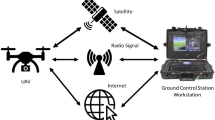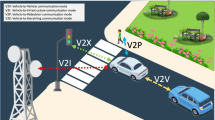Abstract
VANET aims to improve safety for all road users. Vehicles exchange safety messages over wireless communication links which are prone to multiple attacks. To enhance the existing security of V2V communications, we propose in this paper a security framework based on vehicles behavior analysis. We define a Hybrid Trust Model (HTM) and a misbehavior detection system (MDS) where a trust metric is assigned to every vehicle depending on its behavior. Using this trust metric, a classification of the vehicles into malicious or honest is done. HTM is based on-the-fly group formation which helps to manage the communication between vehicles and the back-end system by selecting the most trustworthy node as group leader (GL). Vehicles and GL will cooperate with each other within the group and with the back-end system to detect the malicious node and to notify the Misbehavior Authority. The latter takes appropriate actions to limit the consequences of the malicious behaving node. Performance evaluation of HTM and MDS is carried out using Groovenet Simulator. Results show the efficiency of the proposed model to select the trustworthy vehicles and to monitor their behaviors, as well as to classify them and to deactivate the malicious ones.



























Similar content being viewed by others
References
Hasrouny, H., Samhat, A. E., Bassil, C., & Laouiti, A. (2017). VANET security challenges and solutions: A survey. Vehicular Communications, 7, 7–20.
ETSI TS 102 940 V1.1.1- ITS—Communications security architecture and security management (2012).
IEEE Standard for Wireless Access in Vehicular Environments-Security Services for Applications and Management Messages: IEEE Std 1609.2-2016.
Karagiannis, G., Altintas, O., Ekici, E., Heijenk, G., Jarupan, B., Lin, K., et al. (2011). Vehicular networking: A survey and tutorial on requirements, architectures, challenges, standards and solutions. IEEE Communications Surveys & Tutorials, 13(4), 584–616.
Rawat, D. B., Yan, G., Bista, B. B., & Weigle, M. C. (2015). Trust on the security of wireless vehicular ad hoc networking. Ad Hoc & Sensor Wireless Networks, 24(3–4), 283–305.
Hasrouny, H., Bassil, C., Samhat, A. E., & Laouiti, A. (2016). Security risk analysis of a trust model for secure group leader-based communication in VANET. In Ad hoc networks for smart cities book, IWVSC Malaysia, Springer, Ch.6 (pp. 71–83).
Hartenstein, H., & Laberteaux, K. P. (2008). A tutorial survey on vehicular ad hoc networks. IEEE Communications Magazine, 46(6), 164–171.
Cooper, C., Franklin, D., Ros, M., et al. (2017). A comparative survey of VANET clustering techniques. IEEE Communications Surveys & Tutorials, 19(1), 657–681.
Boneh, D., Boyen, X., & Shacham, H. (2004). Short group signatures. In Annual international cryptography conference (pp. 41–55).
Wu, Q., Domingo-Ferrer, J., & Gonzalez-Nicolas, U. (2010). Balanced trustworthiness, safety, and privacy in vehicle-to-vehicle communications. IEEE Transactions on Vehicular Technology, 59(2), 559–573.
Hasrouny, H., Bassil, C., Samhat, A. E., & Laouiti, A. (2015). Group-based authentication in V2V communications. In Proceedings of IEEE fifth international conference on DICTAP (pp. 173–177).
Wang, J., Jiang, Ch., Zhang, K., et al. (2017). Vehicular sensing networks in a smart city: Principles, technologies and applications. IEEE Wireless Communications, 25(99), 1–11.
Zhang, J. (2011). A survey on trust management for VANETs. In IEEE international conference on advanced information networking and applications (AINA) (pp. 105–112).
Tangade, Sh. S., & Manvi, S. S. (2013). A survey on attacks, security and trust management solutions in VANETs. In IEEE, 4th ICCCNT, Tiruchengode, India (pp. 1–6).
Patel, N., & Jhaveri, R. (2015). Trust based approaches for secure routing in VANET: A Survey. Procedia Computer Science, Elsevier, 45, 592–601.
Kavitha, M., Tangade, Sh. S., & Manvi, S. S. (2013). Distributed trust & time management strategy in VANETs. In IEEE, 4th ICCCNT, Tiruchengode, India (pp. 1–6).
Li, X., Liu, J., Li, X., & Sun, W. (2013). RGTE: A reputation-based global trust establishment in VANETs. In Proceedings of the 5th IEEE international conference on intelligent networking and collaborative systems (INCoS ‘13), China (pp. 210–214).
Lo, N.-W., & Tsai, H.-Ch. (2009). A reputation system for traffic safety event on vehicular ad hoc networks. EURASIP Journal on Wireless Communications and Networking, 2009, 125348.
Primiero, G., Raimondi, F., Chen, T., & Nagarajan, R. (2017). A proof-theoretic trust and reputation model for VANET. In IEEE European Symposium on Security and Privacy Workshops (EuroS&PW) (pp. 146–152).
Hu, H., Lu, R., Zhang, Z., & Shao, J. (2017). REPLACE: A reliable trust-based platoon service recommendation scheme in VANET. IEEE Transactions on Vehicular Technology, 66(2), 1786–1797.
Dixit, K., Pathak, P., & Gupta, S. (2016). A new technique for trust computation and routing in VANET. In Colossal Data Analysis and Networking (CDAN), Symposium on, IEEE (pp. 1–6).
Diep, P. T. N., & Yeo, C. K. (2016). A trust-privacy framework in vehicular ad hoc networks (VANET). In Wireless telecommunications symposium WTS (pp. 1–7).
Kothari, A., Shukla, P., & Pandey, R. (2016). Trust centric approach based on similarity in VANET. In International conference on signal processing, communication, power and embedded system (SCOPES) (pp. 1923–1926).
Rivero-Garcıa, A., Santos-Gonzalez, I., Caballero-Gil, P., & Caballero-Gil, C. (2016). VANET event verification based on user trust. In 24th Euromicro international conference on parallel, distributed, and network-based processing (pp. 313–316).
Mármol, F. G., & Pérez, G. M. (2012). TRIP, a trust and reputation infrastructure-based proposal for vehicular ad hoc networks. Journal of Network and Computer Applications, 35(3), 934–941.
Zhou, A., Li, J., Sun, Q., Fan, C., Lei, T., & Yang, F. (2015). A security authentication method based on trust evaluation in VANETs. EURASIP Journal on Wireless Communications and Networking, 1, 1–8.
Liu, Z., Ma, J., Jiang, Z., Zhu, H., & Miao, Y. (2016). LSOT: A lightweight self-organized trust model in VANETs. Mobile Information Systems Journal. https://www.hindawi.com/journals/misy/2016/7628231/.
Chaurasia, B. K., & Verma, Sh. (2013). Trust based group formation in VANET. MTTER, 2(2), 121–125.
Tajeddine, A., Kayssi, A., & Chehab, A. (2010). A privacy-preserving trust model for VANETs. In 10th IEEE international conference on computer and information technology (CIT 2010).
Gazdar, T., Benslimane, A., Rachedi, A., Belghith, A. (2012). A trust-based architecture for managing certificates in vehicular adhoc networks. In IEEE International Conference on (ICCIT) (pp. 180–185).
Yang, N. (2013). A similarity based trust and reputation management framework for VANET. International Journal of Future Generation Communication and Networking, 6(2), 25–34.
Rehman, A., Ali, A., Amin, R., Shah, A. (2013). VANET thread based message trust model. In Eighth international conference on digital information management (ICDIM).
Xu, H., Hua, L., Ning, Y., & Xue, X. (2013). Detecting the incorrect safety message in VANETS. Research Journal of Applied Sciences, Engineering and Technology, 5(17), 4406–4410.
Sahoo, R. R., Panda, R., Beherab, D. K., & Naskarcm, M. K. (2012). A trust based clustering with ant colony routing in VANET. In Third international conference on computing communication & networking technologies (ICCCNT).
Ltifi, A., Zouinkhi, A., & Bouhlel, M. S. (2015). Trust-based scheme for alert spreading in VANET. In International conference on advanced wireless, information, and communication technologies (AWICT).
Ding, Q., Jiang, M., Li, X., & Zhou, X. (2010). Reputation-based trust model in vehicular ad hoc networks. In IEEE conference on wireless communications and signal processing (WCSP).
Roy, D., & Das, P. (2017). Trust and group leader based model to avoid broadcast storm problem in vehicular ad hoc networks. Advances in Computational Sciences and Technology, 10(4), 575–597.
Khana, U., Agrawala, Sh, & Silakari, S. (2015). Detection of malicious nodes (DMN) in vehicular ad-hoc networks. Procedia Computer Science, 46, 965–972.
Alriyami, Q., Adnane, A., & Smith, A. K. (2014). Evaluation criterias for trust management in vehicular ad hoc networks (VANET). International Conference on Connected Vehicles and Expo (ICCVE) (pp. 118–123).
Whyte, W., Weimerskirch, A., Kumar, V., & Hehn, T. (2013). A security credential management system for V2V communications. In IEEE Vehicular Networking Conference (pp. 1–8).
Manulis, M., Fleischhacker, N., Gunther, F., Kiefer, F., & Poettering, B. (2012). Group signatures: Authentication with privacy. Cryptographic Protocols Group, Department of Computer Science, Technische Universit¨at Darmstadt.
NHTSA, Preliminary Regulatory Impact Analysis FMVSS No. 150 Vehicle-to-Vehicle Communication Technology for Light Vehicles, Report No. DOT HS 812 359 (2016).
Dedicated Short Range Communications (DSRC) Message Set Dictionary, SAE Std. J2735 201 603, March 2016.
Bullen, P. S. (2003). Handbook of means and their inequalities. Berlin: Springer Netherlands.
GroovNet v2.0.1. (2006). Vehicle network simulator. In Second international workshop on vehicle-to-vehicle communications (V2VCOM), San Jose, USA, July 2006, https://github.com/mlab/GrooveNet. Last updated on 2012.
https://www.census.gov/geo/maps-data/data/tiger-line.html. Accessed Aug 2016.
Wang, J., Jiang, Ch., Zhang, K., et al. (2017). Taking drones to the next level: Cooperative distributed unmanned-aerial-vehicular networks for small and mini drones. IEEE Vehicular Technology Magazine, 2(3), 73–82.
Islam, N., Kowsar Hossain, Md., Nawaz Ali, G. G. Md., & Chong, P. H. J. (2016). An expedite group key establishment protocol for Flying Ad-Hoc Network (FANET). In 5th interenational conference on informatics, electronics, and vision (ICIEV).
Author information
Authors and Affiliations
Corresponding author
Rights and permissions
About this article
Cite this article
Hasrouny, H., Samhat, A.E., Bassil, C. et al. Trust model for secure group leader-based communications in VANET. Wireless Netw 25, 4639–4661 (2019). https://doi.org/10.1007/s11276-018-1756-6
Published:
Issue Date:
DOI: https://doi.org/10.1007/s11276-018-1756-6




